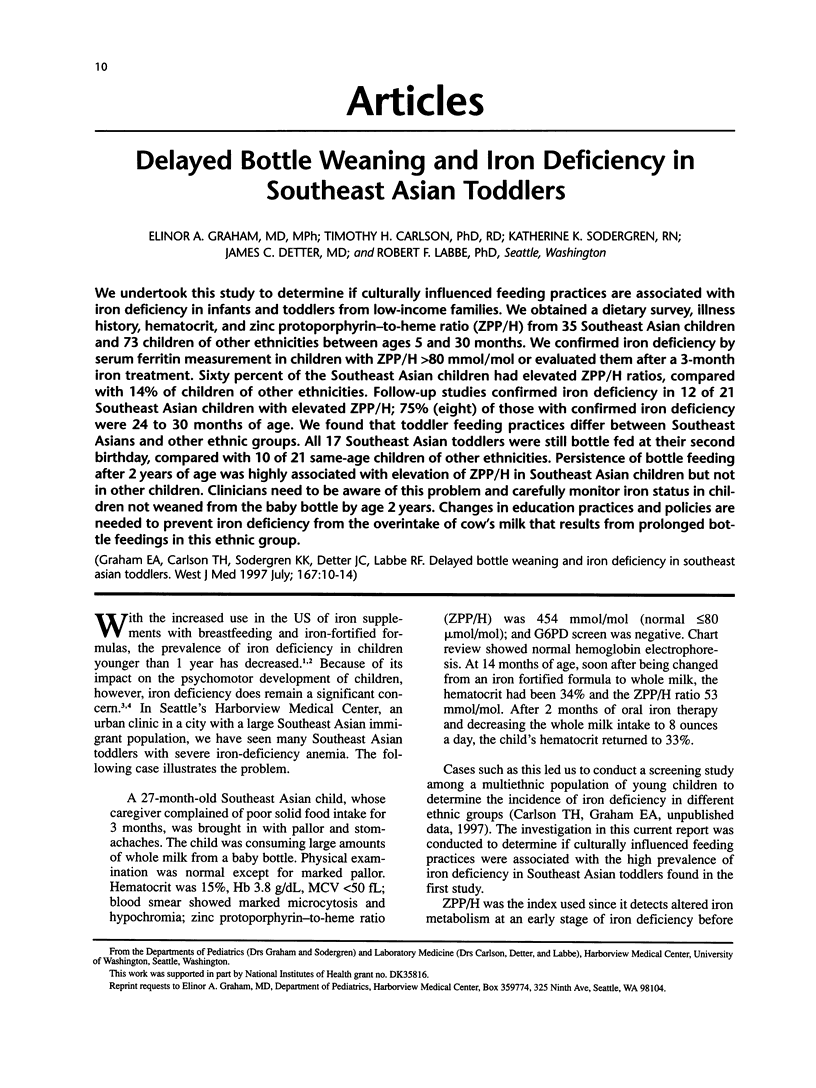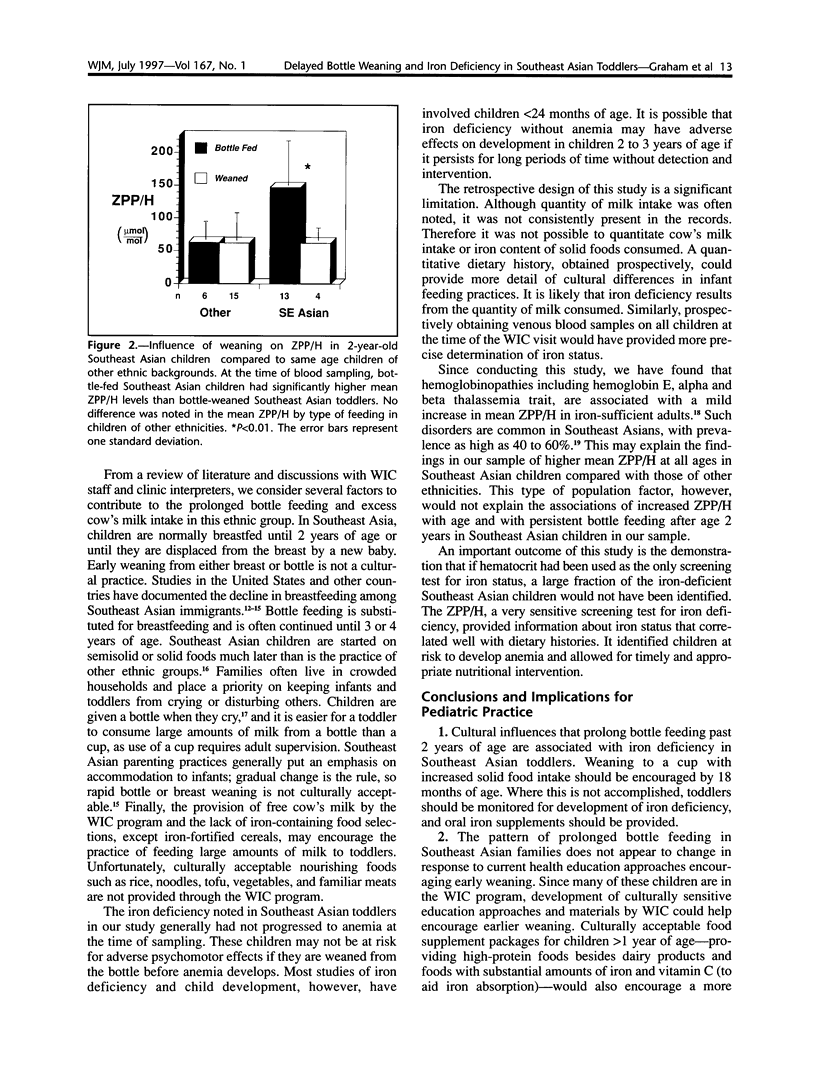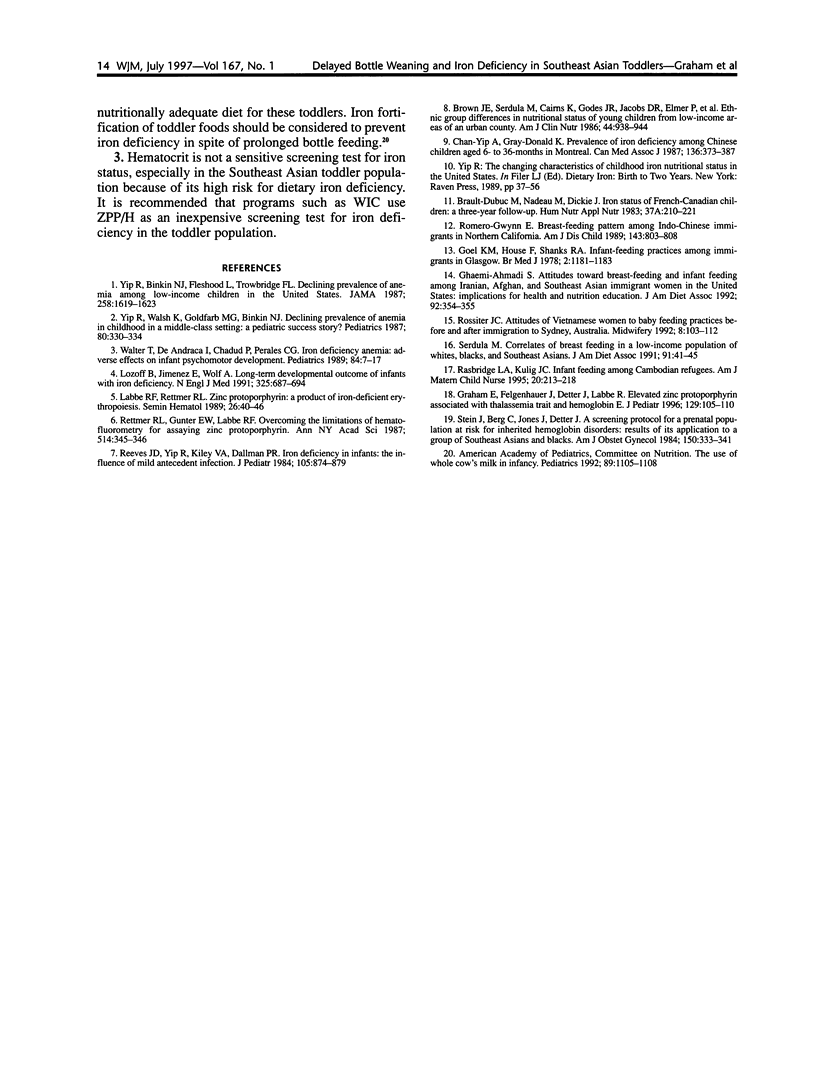Abstract
We undertook this study to determine if culturally influenced feeding practices are associated with iron deficiency in infants and toddlers from low-income families. We obtained a dietary survey, illness history, hematocrit, and zinc protoporphyrin-to-heme ratio (ZPP/H) from 35 Southeast Asian children and 73 children of other ethnicities between ages 5 and 30 months. We confirmed iron deficiency by serum ferritin measurement in children with ZPP/H > 80 mmol/mol or evaluated them after a 3-month iron treatment. Sixty percent of the Southeast Asian children had elevated ZPP/H ratios, compared with 14% of children of other ethnicities. Follow-up studies confirmed iron deficiency in 12 of 21 Southeast Asian children with elevated ZPP/H; 75% (eight) of those with confirmed iron deficiency were 24 to 30 months of age. We found that toddler feeding practices differ between Southeast Asians and other ethnic groups. All 17 Southeast Asian toddlers were still bottle fed at their second birthday, compared with 10 of 21 same-age children of other ethnicities. Persistence of bottle feeding after 2 years of age was highly associated with elevation of ZPP/H in Southeast Asian children but not in other children. Clinicians need to be aware of this problem and carefully monitor iron status in children not weaned from the baby bottle by age 2 years. Changes in education practices and policies are needed to prevent iron deficiency from the overintake of cow's milk that results from prolonged bottle feedings in this ethnic group.
Full text
PDF




Selected References
These references are in PubMed. This may not be the complete list of references from this article.
- Brault-Dubuc M., Nadeau M., Dickie J. Iron status of French-Canadian children: a three year follow-up study. Hum Nutr Appl Nutr. 1983 Jun;37 A(3):210–221. [PubMed] [Google Scholar]
- Brown J. E., Serdula M., Cairns K., Godes J. R., Jacobs D. R., Jr, Elmer P., Trowbridge F. L. Ethnic group differences in nutritional status of young children from low-income areas of an urban county. Am J Clin Nutr. 1986 Dec;44(6):938–944. doi: 10.1093/ajcn/44.6.938. [DOI] [PubMed] [Google Scholar]
- Chan-Yip A., Gray-Donald K. Prevalence of iron deficiency among Chinese children aged 6 to 36 months in Montreal. CMAJ. 1987 Feb 15;136(4):373–378. [PMC free article] [PubMed] [Google Scholar]
- Ghaemi-Ahmadi S. Attitudes toward breast-feeding and infant feeding among Iranian, Afghan, and Southeast Asian immigrant women in the United States: implications for health and nutrition education. J Am Diet Assoc. 1992 Mar;92(3):354–355. [PubMed] [Google Scholar]
- Goel K. M., House F., Shanks R. A. Infant-feeding practices among immigrants in Glasgow. Br Med J. 1978 Oct 28;2(6146):1181–1183. doi: 10.1136/bmj.2.6146.1181. [DOI] [PMC free article] [PubMed] [Google Scholar]
- Graham E. A., Felgenhauer J., Detter J. C., Labbe R. F. Elevated zinc protoporphyrin associated with thalassemia trait and hemoglobin E. J Pediatr. 1996 Jul;129(1):105–110. doi: 10.1016/s0022-3476(96)70196-8. [DOI] [PubMed] [Google Scholar]
- Labbe R. F., Rettmer R. L. Zinc protoporphyrin: a product of iron-deficient erythropoiesis. Semin Hematol. 1989 Jan;26(1):40–46. [PubMed] [Google Scholar]
- Lozoff B., Jimenez E., Wolf A. W. Long-term developmental outcome of infants with iron deficiency. N Engl J Med. 1991 Sep 5;325(10):687–694. doi: 10.1056/NEJM199109053251004. [DOI] [PubMed] [Google Scholar]
- Rasbridge L. A., Kulig J. C. Infant feeding among Cambodian refugees. MCN Am J Matern Child Nurs. 1995 Jul-Aug;20(4):213–218. doi: 10.1097/00005721-199507000-00012. [DOI] [PubMed] [Google Scholar]
- Reeves J. D., Yip R., Kiley V. A., Dallman P. R. Iron deficiency in infants: the influence of mild antecedent infection. J Pediatr. 1984 Dec;105(6):874–879. doi: 10.1016/s0022-3476(84)80069-4. [DOI] [PubMed] [Google Scholar]
- Romero-Gwynn E. Breast-feeding pattern among Indochinese immigrants in northern California. Am J Dis Child. 1989 Jul;143(7):804–808. doi: 10.1001/archpedi.1989.02150190054020. [DOI] [PubMed] [Google Scholar]
- Rossiter J. C. Attitudes of Vietnamese women to baby feeding practices before and after immigration to Sydney, Australia. Midwifery. 1992 Sep;8(3):103–112. doi: 10.1016/s0266-6138(05)80078-6. [DOI] [PubMed] [Google Scholar]
- Serdula M. K., Cairns K. A., Williamson D. F., Fuller M., Brown J. E. Correlates of breast-feeding in a low-income population of whites, blacks, and southeast Asians. J Am Diet Assoc. 1991 Jan;91(1):41–45. [PubMed] [Google Scholar]
- Stein J., Berg C., Jones J. A., Detter J. C. A screening protocol for a prenatal population at risk for inherited hemoglobin disorders: results of its application to a group of Southeast Asians and blacks. Am J Obstet Gynecol. 1984 Oct 15;150(4):333–341. doi: 10.1016/s0002-9378(84)80134-9. [DOI] [PubMed] [Google Scholar]
- Walter T., De Andraca I., Chadud P., Perales C. G. Iron deficiency anemia: adverse effects on infant psychomotor development. Pediatrics. 1989 Jul;84(1):7–17. [PubMed] [Google Scholar]
- Yip R., Binkin N. J., Fleshood L., Trowbridge F. L. Declining prevalence of anemia among low-income children in the United States. JAMA. 1987 Sep 25;258(12):1619–1623. [PubMed] [Google Scholar]
- Yip R., Walsh K. M., Goldfarb M. G., Binkin N. J. Declining prevalence of anemia in childhood in a middle-class setting: a pediatric success story? Pediatrics. 1987 Sep;80(3):330–334. [PubMed] [Google Scholar]


